Stability and Control
Task 1
Three-Body axes of flight (nasa.gov, n.d.)
Axis in a flight is a non-existent line around which an airplane can take a turn. Independent on the type of airplane there are three such axes. The three axes of flight are as follows:
1. Lateral:
Also called pitch. The lateral axis or the pitch passes through the wings. The flight moves up and down along the lateral axis. The image of the lateral axis is as shown in the figure.
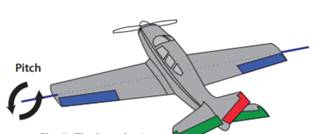
The figure shows a flight with a pitch axis passing through the wings. The arrows show the movement of the flight along the pitch axis. The movements shown here are UP and DOWN.
2. Longitudinal:
Also called Roll. The longitudinal axis or the roll passes through the front part and tail. This imaginary line is the one along which the flight moves forward and backward. The image of the longitudinal axis is given below.
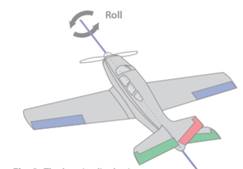
The figure shows a flight with the Roll axis passing through the front part and the tail of the flight. The arrows show the movement of the flight along the roll axis. The movements shown here are FORWARD and BACKWARD.
3. Vertical:
Also called as Yaw. The vertical axis or the Yaw passes through the center of the flight. The flight moves left and right along this axis. The figure shows the Yaw or vertical movement of a flight.
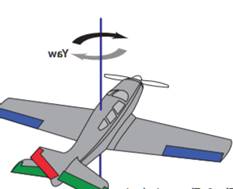
The figure shows a flight with the Yaw axis passing through the center of the flight. The arrow shows the movement of the flight along the Yaw axis. The movements shown here are UP and DOWN.
Aerodynamic moments and forces about three axes (nasa.gov, n.d.)
The Aerodynamic forces acting on the flight are Lift, Drag, Weight, and Thrust. The lift acts in the upper direction, Thrust acts in the front direction, Drag acts in the backward direction and Weight acts in a downward direction at the point of the center of mass. The following figure shows the forces acting on the flight.
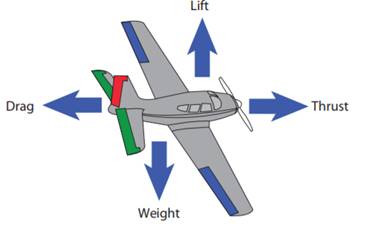
1. Thrust: The engine or propulsion system of the flight is responsible for the generation of the thrust. The thrust decides where the flight will move. The direction of motion depends on the direction of the thrust. For instance, if the flight's engine propulsion is pointed in backward then the thrust will be generated in a forward direction and thereby the flight moving in a forward direction.
2. Lift: The lift is the force that is pointed in the upper direction. The lift is produced by the stream of air below the wings. The lift can be determined by Bernoulli's principle. The direction is always perpendicular to the flight movement. The main factors which determine the magnitude of the lift are size, velocity, and shape of the flight.
3. Drag: The drag is the force generated by the air resistance. The drag is produced due to the newton's third law of motion. The Drag reduced the thrust. There are many kinds of thrust but the direction is always perpendicular to the lift and opposite to the flight's thrust generated.
4. Weight: The weight is generated due to the gravitation force directed in a downward direction at the center of mass. The weight of the flight is given by Mg, where M is the mass of all components of the flight and the g is the gravitational constant, approximately its value is 9.98 meter per second-square. The components responsible for the weight are the main parts of the flight like engine, wings, propellers, etc. Other than these weight of cargo, people in the flight and the fuel is also considered. The weight is applied throughout the flight. But its impacts can be considered at a single point called the center of mass.
The weight and lift acts in the opposite direction and the lift generated must be greater than the weight, so as to make the flight fly. The lift and weight act on the flight as follows.
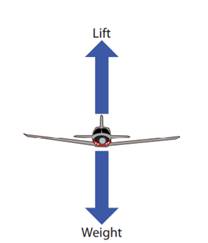
The components of the aerodynamic forces and moments are given as follows: (aviation.stackexchange.com, n.d.)
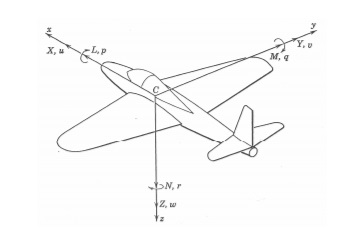
Here, the coordinates x, y, and z along the plane of the axes of the flight namely pitch, roll, and Yaw respectively.
u, v and w are the components of linear velocity. The direction of them is the direction of x, y and z axes, respectively.
X, Y, and Z are the aerodynamic forces acting on the flight.
p, q, and r are components of rotational velocity.
L, M, and N are the components of aerodynamic moments.
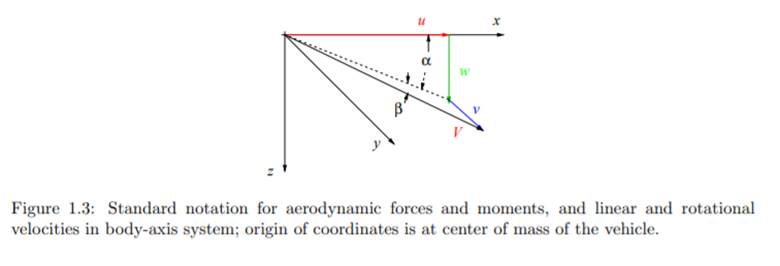
Angle of attack
The angle formed between the relative winds with the wings of the airplane. The angle can be formed chord of the wings extended and the relative wind direction.
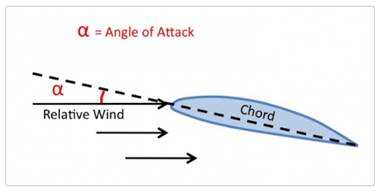
The angle of sideslip: The rotation of the flight from the centerline with the wind.
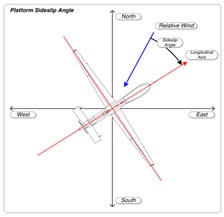
Balanced Flight (aviationstackexchange, n.d.)
Before studying various stabilities, we must know what a balanced flight is. The balanced flight can be simply defined as the aircraft which is in equilibrium. The flight which has all the forces acting on it balanced. The forces acting on the forward direction must be equal to the forces acting backward and the forces acting upward must be equal to forces acting downwards.
Static stability
The static stability is of three types:
Positive static stability is defined as a condition when the flight comes back to its original state (say altitude) when disturbed. For instance, if an aircraft flies at some particular altitude and then suddenly it experiences turbulence the flight recovers and comes back to its original altitude.
Neutral static stability is defined as a condition when the flight accepts the new state. For instance, a flight flies at a particular altitude and experiences turbulence which makes its nose move up at 3 degrees. The flight now moves with its nose at 3 degrees and stabilize.
Negative static stability is defined as a condition when the flight keeps moving in a new direction when disturbed. For instance, if a flight is experienced some kind of turbulence then it will continue moving in the same direction. It is a very undesirable condition for the flights.
Dynamic stability
The dynamic stability of an aircraft is defined as a tendency of a flight to return to its original state when disturbed but the flight doesn’t return to its original state directly it returns slowly and gradually with reducing frequency. They are of three types:
In Positive dynamic stability, the oscillations are damped with the time. For instance, if a flight goes down when the flight is pulled up it doesn't pull up at once. The flight is pitch up for a while then goes down, these oscillations repeat for a while and then the final normal state is attained.
In Neutral dynamic stability, the oscillations never damp. If an aircraft is pulled up and then to normalize pulled down it will start oscillating and the oscillations will continue.
Negative dynamic stability means the oscillation gets worse with time. If an aircraft is pulled up it will increase the frequency randomly.
Longitudinal stability
We know, that the longitudinal axis is the imaginary line passing through the head and tail of an aircraft. The longitudinal stability as the name suggests is the stability of the flight with respect to its longitude. It is the ability of the flight to return back to the trimmed angle of attack. The ailerons control the longitudinal stability of a flight.
Lateral stability
Similar to longitudinal stability the lateral stability is the stability of the flight with respect to its lateral axis. The stability is maintained using elevators.
Dihedral effect: The lift generated due to an increase in the angle of attack.
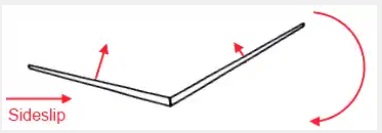
Swept Wing effect: A rollback created due to more directive wind.
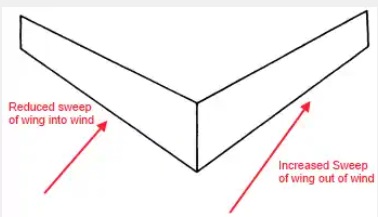
Directional stability: Strength around the vertical pivot. Vertical tail achieves this.
You should have more surface territory behind the CG than before it.
Static margin is the distance between the neutral point of aircraft and the center of gravity. This is measured in percentages. The mean is calculated for an aerodynamic chord of the wing.
Neutral point’s location is obtained finding the point where the moment’s algebraic sum is zero. Similarly, the c.g. is obtained by finding the location where all components of weight of the body can be contained. Now the distance between these two is calculated to obtain the static margin.
Effects of static margin on stability: (cfinotebook, n.d.) The more the distance between two points more the stability. Usually, the point of neutrality is placed behind the c.o.g. In some cases, the neutral point is kept in front of the center of gravity to make it unstable. So that it becomes responsive.
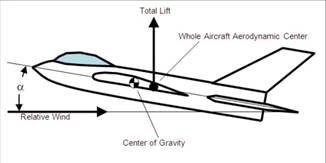
Dutch Roll: Coupling of the parallel and directional tomahawks causes Dutch roll. Dutch move is a joined yawing-moving movement of the airship and might be viewed as just a disturbance except if permitted to advance to huge bank edges. Huge rolling and yawing movements can become perilous except if appropriately damped.
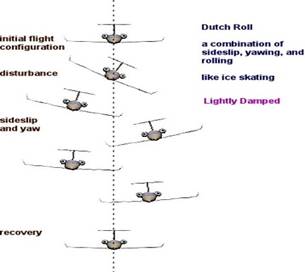
The spiral mode l is a model which doesn’t consider the oscillations. To obtain it we need to find the root of its polynomial. When excitation is reached, the development of dynamics (mode) becomes slow and coupling becomes complex in yaw, roll, and sideslip.
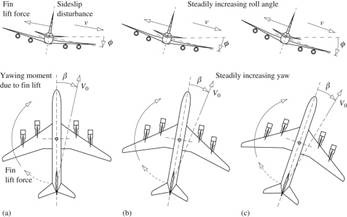
Dihedral angle: (courses.cit, n.d.) The angle produced by the wings with the lateral axis. In other words, the bend in the aircraft wings can be said to be its dihedral. The necessity of the bend of the wings is that the horizontal component of the lift will make the flight bend on the right side. Due to this, it will be nearly impossible to keep the plane straight. As it will continuously bend the flight in one direction.
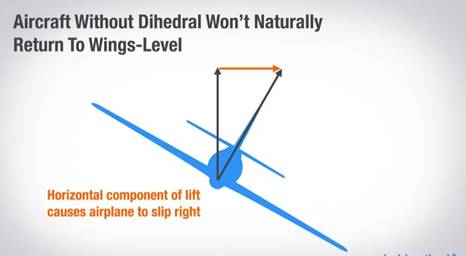
Dihedral’s effect to solve the problem:
1. The right side bending of the flight will lead to the relative wind's effect on change. In order to make them neutralize the effect, the dihedral of the wings is a must.
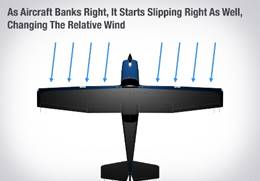
2. Second, in light of the fact that the breeze has the inward directed segment, and on the grounds of tilting of wings, a segment of the breeze acts on the low wing’s underside, driving it to the actual position. What's truly occurring here is the low wing is flying at a higher AOA, and creating more lift.
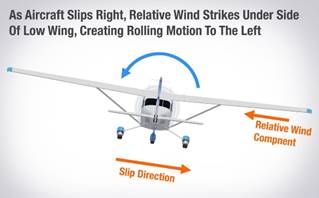
The more dihedral an airship has, the more articulated is the impact. In any case, for most airplanes, the dihedral is just a couple of degrees, which is sufficiently only to balance during the unsettling influences, similar to disturbance, or knocking the flight controls in the cockpit.
Effects of Sweep angle (/encyclopedia2.thefreedictionary.com/, n.d.)
A leveling of the lift bend incline for two reasons:
1. The compelling approach is decreased by the cosine of the scope edge.
2. Only the segment of speed ordinary to the quarter-harmony line of the wing is making the lift, so a cleared wing makes less lift per region than a straight wing.
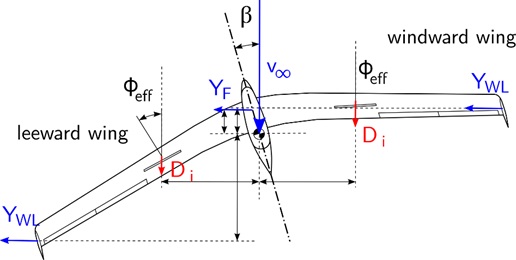
The expanded lift rolls the flying machine, yet in addition, produces expanded lift-initiated drag which destroys it back to straight flight.
The impact on longitudinal size change in tail size
With an increase in tail size, the static margin will increase thereby the stability increase.
The impact on longitudinal size change in elevator size
The stability will increase with the increase in elevator size.
What determines the longitudinal stability of an airplane?
a) Relationship of thrust to weight and drag
Minimum condition for longitudinal stability:
B) Cm (alpha) < 0, Cm0 > 0
Minimum condition for static directional stability:
C) Cn(beta) > 0, C1(beta) < 0
Task 2
Stability (history.nasa.gov, n.d.)
The flight which has every one of the powers following up on it adjusted. The powers following up on the forward course should be equivalent to the powers acting in reverse and the powers acting upward should be equivalent to powers acting downwards.
Static stability
The static stability of a flight just means its inclination to come back to the first position when upset. The static solidness is of three kinds:
Positive static stability is characterized as a condition when the flight returns to its unique state (say elevation) when upset.
Neutral static stability is characterized as a condition when the flight acknowledges the new state.
Negative static stability is characterized as a condition when the flight continues moving toward another path when upset.
Dynamic stability
The dynamic stability of a flight is characterized as an inclination of a trip to come back to its unique state when upset yet the flight doesn't come back to its unique state straightforwardly it returns gradually and progressively with decreasing recurrence. They are of three kinds:
In Positive dynamic stability, the motions are damped with the time. For example, if a flight goes down when the flight is pulled up it doesn't pull up on the double.
In Neutral dynamic stability the motions never soggy. On the off chance that an airplane is pulled up and, at that point to standardize pulled down it will begin wavering and the motions will proceed.
Negative dynamic stability implies the wavering gets exacerbate with the time. On the off chance that an airship is pulled up, it will expand the recurrence haphazardly.
Controllability (howthingsfly.si.edu, n.d.)
The reaction of a flight inconsistent flight, on pilot control inputs. For example, avoiding the ailerons: a high coming about move rate implies a quick reaction.
Types of controllability are:
1. State controllability: The condition of a deterministic framework, which is the arrangement of estimations of all the framework's state factors, totally depicts the framework at some random time. Specifically, no data on the part of a framework is expected to help in foreseeing the future, if the states right now are known and all present and future estimations of the control factors are known.
2. Output controllability is the related thought for the yield of the framework (meant y in the past conditions); the yield controllability depicts the capacity of outer contribution to moving the yield from any underlying condition to any last condition in a limited time interim.
|
Stability |
Controllability |
|
The flight which has every one of the powers following up on it adjusted. The powers following up on the forward course should be equivalent to the powers acting in reverse and the powers acting upward should be equivalent to powers acting downwards. |
The reaction of a flight inconsistent flight, on pilot control inputs. For example, avoiding the ailerons: a high coming about move rate implies a quick reaction. |
|
Types: Static stability and dynamic stability |
Types: Input controllability and output controllability |
Longitudinal control (aviationstackexchange, n.d.)
We know, that the longitudinal axis is the nonexistent line going through the head and tail of an airplane. The longitudinal soundness as the name proposes is the steadiness of the trip as for its longitude. It is the capacity of the trip to return back to the cut approach. The ailerons control longitudinal steadiness of a flight.
Yaw control (aviationstackexchange, n.d.)
Dynamic Yaw Control is a unique steadiness control framework that continues longitudinal increasing speed and improves sidelong strength by controlling torque-inclination between the back wheels. Dynamic yaw control expands cornering and footing execution utilizing a PC controlled back differential.
Effect of the tail on stability (howthingsfly.si.edu, n.d.)
The streamlined focus of the plane, for the most part, is near the streamlined focal point of the wing alone. It lies in the rear of or more the focal point of gravity. The push line may lie above or beneath the focal point of gravity; for this situation, above. The minutes about the focal point of gravity are the powers times the separation among them and the focal point of gravity. It is found for this situation that the lift and push both contribute nose-down minutes while the drag contributes a nose-up minute. In the event that these don't counterbalance one another, the plane won't be in harmony. It is apparent that another minute source is the required flat tail. The level tail goes about as a little wing and the pilot can accomplish lift or negative lift by lift control. Due to the long minute arm from the focal point of gravity to the streamlined focus of the flat tail, just moderately little powers are required. In this way, the level tail supplies the adjusting minute. To fly in a specific balance condition, the lift is "cut" to a specific point. The complete minute about the plane focus of gravity is zero.
Effect of wings on stability (howthingsfly.si.edu, n.d.)
1. The right side bowing of the flight will prompt the relative breeze's impact to change. So as to make them kill the impact the dihedral of the wings is a must.
2. Second, in light of the fact that the breeze has the inward directed segment, and on the grounds of tilting of wings, a segment of the breeze acts on the low wing’s underside, driving it to the actual position. What's truly occurring here is the low wing is flying at a higher AOA, and creating more lift. The more dihedral an airship has, the more articulated is the impact. In any case, for most airplanes, the dihedral is just a couple of degrees, which is sufficiently only to balance during the unsettling influences, similar to disturbance, or knocking the flight controls in the cockpit.
Conclusion
In a flight there are three types of axes, namely lateral, longitudinal and vertical. There are various forces and moments that act on a flight. The flight to remain in a balanced condition all the forces and moments must be balanced. The forces acting on a flight are lift, drag, thrust and weight. The static stability of an aircraft simply means its tendency to return to the original position when disturbed. They are of three types positive, neutral and negative. The dynamic stability of an aircraft is defined as a tendency of a flight to return to its original state when disturbed but the flight doesn’t return to its original state directly it returns slowly and gradually with reducing frequency. They are also of three types positive, neutral and negative. The stability and controllability are different things. The controllability is a reaction of a flight inconsistent flight, on pilot control inputs. The wings and tail are very important in determining stability.
References
/encyclopedia2.thefreedictionary.com/ . (n.d.). Retrieved from https://encyclopedia2.thefreedictionary.com/longitudinal+control
aviation.stackexchange.com . (n.d.). Retrieved from https://aviation.stackexchange.com/questions/17291/what-are-lateral-longitudinal-and-directional-stability
aviationstackexchange . (n.d.). Retrieved from https://aviation.stackexchange.com/questions/44236/controllability-vs-stability-in-phak-is-it-an-error
cfinotebook . (n.d.). Retrieved from https://www.cfinotebook.net/notebook/aerodynamics-and-performance/aircraft-stability
courses.cit . (n.d.). Retrieved from https://courses.cit.cornell.edu/mae5070/Caughey_2011_04.pdf
history.nasa.gov . (n.d.). Retrieved from https://history.nasa.gov/SP-367/chapt9.htm
howthingsfly.si.edu . (n.d.). Retrieved from https://howthingsfly.si.edu/flight-dynamics/roll-pitch-and-yaw
nasa.gov . (n.d.). Retrieved from https://www.nasa.gov/sites/default/files/atoms/files/axes_control_surfaces_5-8.pdf
Buy Stability and Control Assignment Answers Online
Talk to our expert to get the help with Stability and Control Assignment to complete your assessment on time and boost your grades now
The main aim/motive of the management assignment help services is to get connect with a greater number of students, and effectively help, and support them in getting completing their assignments the students also get find this a wonderful opportunity where they could effectively learn more about their topics, as the experts also have the best team members with them in which all the members effectively support each other to get complete their diploma assignments. They complete the assessments of the students in an appropriate manner and deliver them back to the students before the due date of the assignment so that the students could timely submit this, and can score higher marks. The experts of the assignment help services at urgenthomework.com are so much skilled, capable, talented, and experienced in their field of programming homework help writing assignments, so, for this, they can effectively write the best economics assignment help services.
Get Online Support for Stability and Control Assignment Assignment Help Online
Resources
- 24 x 7 Availability.
- Trained and Certified Experts.
- Deadline Guaranteed.
- Plagiarism Free.
- Privacy Guaranteed.
- Free download.
- Online help for all project.
- Homework Help Services
Testimonials
Urgenthomework helped me with finance homework problems and taught math portion of my course as well. Initially, I used a tutor that taught me math course I felt that as if I was not getting the help I needed. With the help of Urgenthomework, I got precisely where I was weak: Sheryl. Read More

